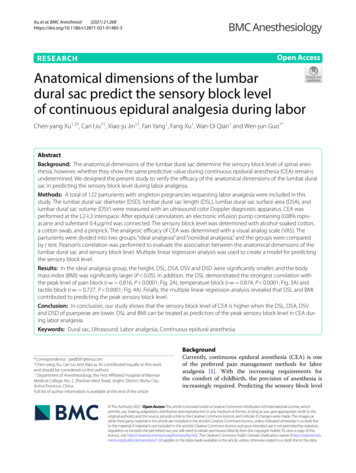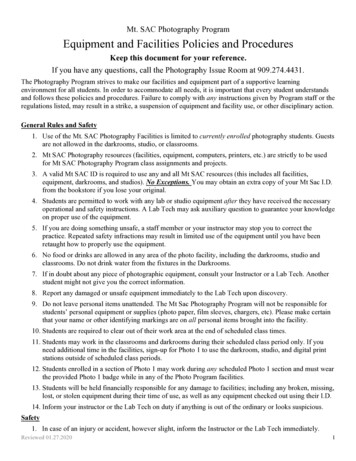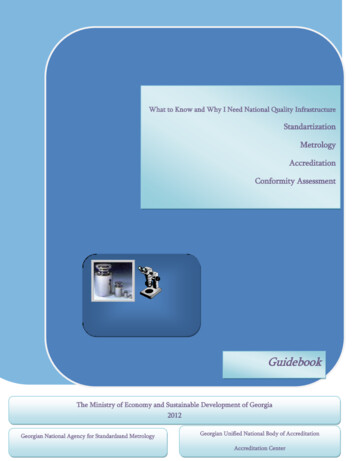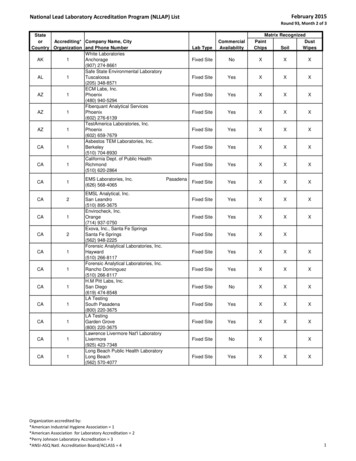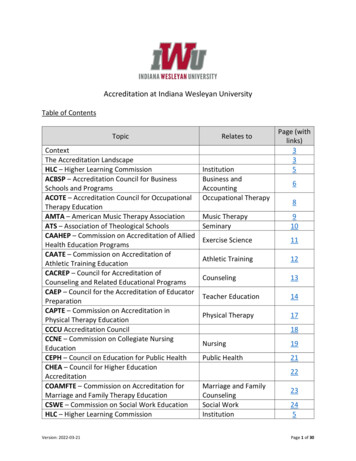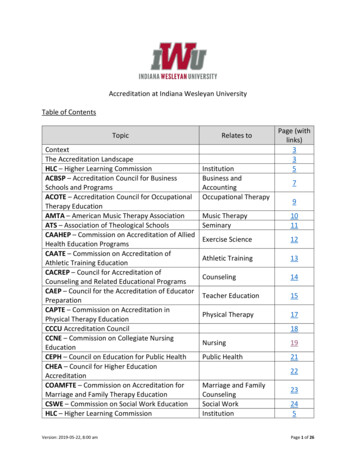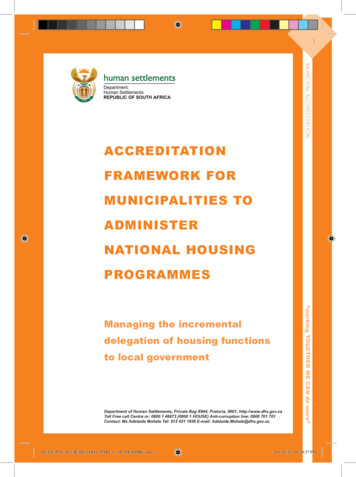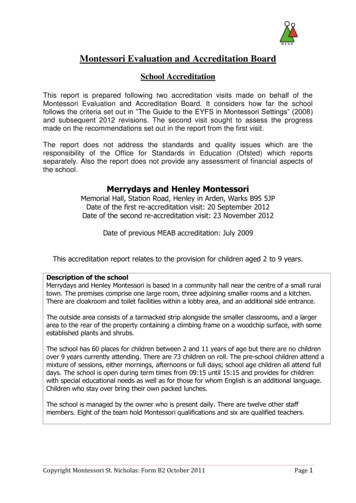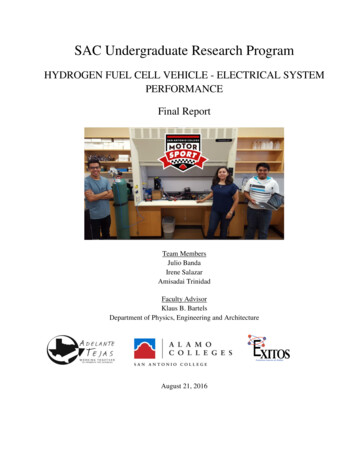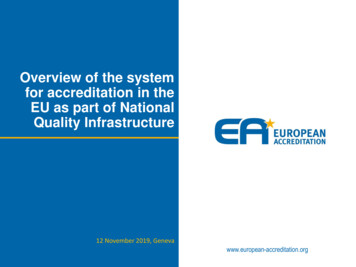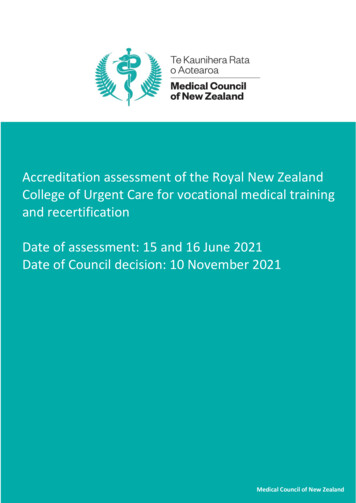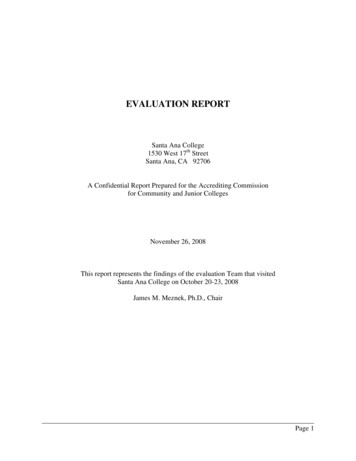
Transcription
EVALUATION REPORTSanta Ana College1530 West 17th StreetSanta Ana, CA 92706A Confidential Report Prepared for the Accrediting Commissionfor Community and Junior CollegesNovember 26, 2008This report represents the findings of the evaluation Team that visitedSanta Ana College on October 20-23, 2008James M. Meznek, Ph.D., ChairPage 1
Comprehensive Evaluation Visiting Team RosterSanta Ana CollegeMonday, October 20 – Thursday, October 23, 2008Dr. James Meznek (Chair)ChancellorVentura County Community College DistrictDr. Richard Dawe (Team Assistant)Vice Chancellor, Planning and OperationalDevelopmentVentura County Community College DistrictDr. Loretta AdrianVice President Student ServicesSkyline CollegeDr. Renee KilmerVice President of InstructionCabrillo CollegeDr. Richard DuránPresidentOxnard CollegeDr. William HirtGeology InstructorCollege of the SiskiyouDr. Jack LucasTrusteeWest Valley-Mission CCDMs. Barbara McNeice-StallardDirector, Research & InstitutionalEffectivenessMt. San Antonio CollegeMr. Paul SavoieAssistant Professor, History and PoliticalScienceLong Beach City CollegeDr. Jon C. StephensVice President Business ServicesSan Joaquin Delta CollegeMs. Lynn-Marie Glaze (Team Assistant)Executive AssistantVentura County Community College DistrictPage 2
Summary of the Evaluation ReportINSTITUTION:Santa Ana CollegeDATE OF VISIT:October 20-23, 2008TEAM CHAIR:James M. Meznek, ChancellorVentura County Community College DistrictA nine-member accreditation Team with two Team assistants visited Santa Ana College fromOctober 20-23, 2008 for the purpose of evaluating the institution’s request to reaffirmaccreditation. In preparation for the visit, the Team chair attended an all-day chair trainingworkshop on August 19, 2008, and the chair and Team members participated in a full day Teamtraining workshop on September 10, 2008 conducted by the Western Association of Schools andColleges, Accrediting Commission for Community and Junior Colleges (WASC, ACCJC).Members of the Team reviewed the Commission’s Handbook for Evaluators, the AccreditationReference Handbook, the Team Evaluator Manual, and the Distance Learning Manual, as well asthe college’s audit, fiscal, and federal student aid eligibility reports prior to their visit. Inaddition, Team members carefully read the college’s self study and found it to be well writtenand comprehensive.The Team chair and assistant conducted pre-visit meetings with the college president and districtchancellor on September 17, 2008, to clarify the expectations of the Team and to assure that alllogistical arrangements for the visit were in order.Several weeks prior to the Team visit, each member prepared a written report of their assessmentof the entire self study and the specific accreditation standard to which they had been assigned.Team members also identified those persons with whom they wished to confer while on campus,and this information was shared with the college. On October 20, 2008, the Team met to reviewthe self study, and share observations regarding the conclusiveness of its propositions andPage 3
evidence. The Team found the self study satisfactorily addressing all standards and thecommission’s eligibility requirements.During the site visit, Team members held over 50 individual or group meetings with collegeboard members, employees, students, and community representatives. Two well-attended openmeetings were also provided for those wishing to speak to Team members. The Team revieweddocuments supporting the self study report as well as board policies and regulations, officialrecords, board and committee minutes, and online information. The Team also visited a widevariety of academic and student support facilities and observed classroom and online instruction.Two members of the Team visited the college’s Centennial Education Center and several Teammembers attended committee meetings taking place on campus during the visit. In addition, theTeam coordinated its observations and findings on district-wide matters with the Teamconcurrently visiting Santiago Canyon College.The Team greatly appreciated the enthusiasm and support provided by college staff throughoutthe visit. Personnel responded quickly to Team requests. Staff were open and candid in theirresponses to Team members’ questions. The Team noted the college’s self study was extremelyuseful to its members due to its thoroughness, clarity, and completeness. A district/multi-collegemapping document delineated district-wide and campus functions and authority. The Teamwork room was provided with well-organized evidentiary documents referenced in the self study,as well as online computer access to supporting policies and regulations.Page 4
INTRODUCTION AND SUMMARYSanta Ana College was established as a “Junior College” within Santa Ana High School in 1915.An earthquake forced the college to relocate to a new site on North Main Street in 1933. In1947, the institution moved to its current location on Bristol Street. It is the fourth oldest publictwo-year college in California.Santa Ana College formally separated from the Santa Ana Unified School District to form theRancho Santiago Community College District (RSCCD) in 1971. Fourteen years later, in 1985,the District’s Orange Campus instructional site began providing classes and programs tostudents. Renamed Santiago Canyon College, the campus became an independent districtcollege in 1997.Rancho Santiago Community College District educates approximately 36,000 students in creditprograms and 19,000 in non-credit programs. The District’s student enrollment is also fourthlargest in California. The District encompasses the communities of Anaheim Hills, GardenGrove, Irvine, Orange, Santa Ana, Tustin, and Villa Park. Approximately 700,000 residents livewithin the 193 square miles of the District service area.The main campus of Santa Ana College is located at the corner of 17th and Bristol Streets andoccupies an area of sixty-five acres in the geographic center of Orange County. Santa AnaCollege serves approximately 40,000 students per semester in both the credit and non-creditprograms at its main campus and community sites. Santa Ana College operates the CentennialEducation Center as its administrative site for the School of Continuing Education (SCE) offeredthroughout approximately one hundred locations in the community. The SCE provides a broadarray of non-credit courses to address the needs of a diverse population of adult learners.Enrollment averages approximately 20,000 students, with the greatest portion enrolled in Englishas a Second Language courses. Other course offerings include adult basic education, high schoolcompletion, parent education, and vocational training.Page 5
At the time of its site visit, the college had 593 full time employees in a variety of positionsincluding 38 administrators, 276 classified employees, and 279 faculty. As of fall 2007, 47% ofthe faculty, 59% of the classified, and 61% of the administrative employees were female.Approximately 48% of the college’s full time workforce is white, 32% Hispanic, 11% Asian, and4% African-American.During fall 2007, 45% of the college’s credit enrollment constituted Hispanic students. Thirtyone percent of the students were white, 11% Asian, and 2% African-American. Eleven percentof the student body classified themselves as “other.”Among students enrolling in non-credit courses during fall 2007, 4% were Asian, 53% Hispanic,3% white, and 1% African-American. Thirty-eight percent of the non-credit students classifiedthemselves as “other.”Page 6
RESPONSES TO THE RECOMMENDATIONS OF THE 2001 TEAM VISITIn 2001, Santa Ana College applied for and was awarded Reaffirmation of Accreditation byACCJC. An Interim Report addressing Recommendation 5 of the evaluation Team ofOctober 2001 was completed in February 2003. A Focused Midterm Report was then issued inOctober 2004 regarding Recommendation 5 and all other recommendations of the October 2001evaluation Team. The Focused Midterm Report was accepted with the requirement of aProgress Report followed by a visit of commission representatives. In October 2005, a ProgressReport addressing Recommendation 5 was completed, and a Team visit was held inNovember 2005. No further recommendations were issued by WASC.2001 Team Recommendation 1The Team recommends that campus policies that affect student behavior and activities, such asstudent conduct, student grievances, discrimination, complaint procedures, civility, as well asacademic honesty be widely disseminated in a format that is understood by the college’s studentpopulation. Special efforts should be made to make this information available at all locationsoffering credit and non-credit courses. (Former Standard 2.1, 2.6)2008 Team Finding for Recommendation 1The 2008 Team found that Recommendation 1 had been fully addressed.2001 Team Recommendation 2b2b: Standard IB, IIADeveloping appropriate means for assessing student learning at the course, program, degree, andinstitutional levels; tie student learning outcome measures to the expectations of stakeholders(employers, transfer institutions, next course in a series); demonstrate how the regular review ofstudent performance has led to improvements in curriculum and instructional delivery. (FormerStandard 3C.1, 3C.2)Page 7
2008 Team Finding for Recommendation 2bThe 2008 Team found that Recommendation 2b had been fully addressed.2001 Team Recommendation 2c2c: Standard IB, IIIB, IIIDMaking planning more comprehensive, with clear connections between planning at thedepartment, college, and district levels; indicate how institutional effectiveness data are used inplanning and how accomplishments of objectives are tracked; develop linkages betweenfinancial, facilities (including capital construction and major maintenance), human resource,information technology and program planning, including identification and interdependencies ineach are (the “total cost of ownership” concept). (Former Standard 3B.3, 8.5, 9A.1)2008 Team Finding for Recommendation 2cThe 2008 Team found Recommendation 2c had been partially addressed. Planning andassessment was made more comprehensive at the college. However, there was no evidence ofclear links between planning, budgeting, and resource allocation. Further, no evidence wasidentified that the “total cost of ownership” concept for planning had been adopted by theinstitution, nor that integrated human resource planning was taking place.2001 Team Recommendation 2d2d: Standard IB, IIIDEnsuring that all processes for allocating resources (operating budgets, discretionary funds,staffing, and capital equipment) rely on college plans for establishing priorities. (FormerStandard 3B.2, 9A.1, 9A.3)2008 Team Finding for Recommendation 2dThe 2008 Team found Recommendation 2d had been partially addressed. The district BudgetAllocation and Planning Review (BAPR) Committee had established methods by which fixedexpenses are funded and discretionary funds are allocated among the district office and its twocolleges. Evidence relating to the integration of planning, staffing and budgeting was notidentified.Page 8
2001 Team Recommendation 3aThe Team recommends that employee evaluation systems be reviewed such that:3a: Standard IIIAClassified employees are evaluated in a timely fashion as called for in policy andagreements. (Former Standard 7B.1)2008 Team Finding for Recommendation 3aThe 2008 Team found Recommendation 3a had been fully addressed.2001 Team Recommendation 3b3b: Standard IIIAConsideration be given to including the opportunity for positive comment in faculty evaluationforms and requiring peer classroom observation in the evaluation processes for tenured faculty,as additional methods of promoting effective teaching. (Former Standard 7B.2)2008 Team Finding for Recommendation 3bThe 2008 Team found Recommendation 3b had been fully addressed.2001 Team Recommendation 4aRecommendation 4: Standard IIIDThe Team recommends that the Santa Ana College members of the Budget Allocation andPlanning Review Committee, working with the others on that body, provide leadership. (FormerStandard 9A.1, 9A.2, 9A.4, 9A.5)4a. to develop criteria for making allocation decisions at the district level.2008 Team Finding for Recommendation 4aThe 2008 Team found Recommendation 4a had been fully addressed.2001 Team Recommendation 4bPage 9
4b. to evaluate the effectiveness of the resource allocation process.2008 Team Finding for Recommendation 4bThe 2008 Team found Recommendation 4b had not been addressed. The college did not have amechanism to assess the effectiveness of previous budget initiatives. This is critical to evaluatethe outcomes of budget allocations and make decisions in the subsequent budgets.2001 Team Recommendation 4c4c. to link decisions to college plans.2008 Team Finding for Recommendation 4cThe 2008 Team found Recommendation 4c had been partially addressed. Apart from dialogueregarding committee meeting discussion of its decisions the complex nature of college planningmakes the linkage between planning and decision making nontransparent to constituents.2001 Team Recommendation 4d4d. to disseminate information to the colleges on the criteria and process.2008 Team Finding for Recommendation 4dThe 2008 Team found Recommendation 4d had not been addressed. Apart from dialogueregarding committee meeting discussion of budget criteria and process, no evidence could beidentified that the college has attempted to disseminate information to the campus community.2001 Team Recommendation 5aRecommendation 5The Team recommends that special attention be given to the evolving relationship between thedistrict and the college. Experience to date and candid evaluation of that experience should nowpermit:5a:IVA in consultation with the appropriate district and college leaders, a specificationof the ultimate district/college relationships and governance structures desired, with anPage 10
estimated timeline for achieving these arrangements; the Board should periodically beapprised of progress being made. (Former Standard 10C.3)2008 Team Finding for Recommendation 5aThe 2008 Team found Recommendation 5a had been fully addressed.2001 Team Recommendation 5b5b: IVBAdministrative structures to be designed consistent with the governance structures desired, withan estimated timeline for moving functions and appropriate administrative capacity to theappropriate locations.2008 Team Finding for Recommendation 5bThe 2008 Team found Recommendation 5b had been fully addressed.2001 Team Recommendation 6The Team recommends that, working with the Chancellor, the Board of Trustees review its selfevaluation practices and consider additional processes that would establish criteria for Boardperformance, develop measures of performance relating to the criteria, periodically evaluateperformance, and discuss specific steps for improvement. (Former Standard 10A.5)2008 Team Finding for Recommendation 6The 2008 Team found Recommendation 6 had been partially addressed. Since the last Team’svisit, the Board of Trustees approved a revised Trustee evaluation policy (BP 9022) andimplemented a self evaluation relate to three criteria. The Board has subsequently conducted selfevaluations almost every year and is considering changes in its assessment criteria. However, itis not clear that the Board used this information to improve performance other than compare theprevious year’s evaluation to the one being conducted, nor is it clear that the Board has evaluatedthe self evaluation model.Page 11
College CommendationsThe Team was impressed with the dedication and commitment of trustees, employees andcommunity members to Santa Ana College in meeting its mission through its many fineprograms and services. Two activities were noted by the Team as warranting commendation asmodels of outstanding institutional practice:1) The college is commended for creating and maintaining the physical infrastructure,operations, and technology necessary to support approximately 100 alternative learning deliverysites across its community. These learning sites offer a wide range of specialized instructionaland support programs that address the unique needs of diverse student populations in accessiblelocations.2) The college is commended for the creation and operation of its web-based “Dashboard”management information tool. The Dashboard approach allows members of the collegecommunity to access data necessary for decision making within a systematic culture of evidenceand cycle of continuous improvement.2008 Team RecommendationsCollege RecommendationsCollege Recommendation 1The Team recommends that the college evaluate its planning processes, including the integrationof technology, staffing, and facilities master plans, to ensure the budget is used as a planning toolto achieve its strategic goals and that the outcomes from these activities be formally and broadlycommunicated to ensure quality. As part of this integration, the Team recommends that thecollege resource allocation be based on plans, program reviews (Department Planning Portfolios,or DPPs), and actual budgetary performance. This requires that the college evaluate theoutcomes of its planning/budget process and use that data in subsequent budget development.(Standards I.A.1, I.A.3, I.B.4, I.B.6, II.A.1, II.A.2.f, III.B.2.d, III.D.1, III.D.2, III.D.3, IV.B.3.a,IV.B.3.b)Page 12
College Recommendation 2In order to fully meet standards II and III, the Team recommends that the college prepare andmaintain an updated Diversity Plan. (Standards II.A.1.a, II.A.3.c, II.B.3.d, III.A.4.a, III.A.4.b)College Recommendation 3The Team recommends that the college strengthen its communication with classified employeesregarding governance service opportunities, processes, deliberations, and outcomes. (StandardsIII.A, IV.A.1)District RecommendationsDistrict Office ReviewDuring the course of the concurrent accreditation visits at Santa Ana and Santiago CanyonColleges, district trustees and staff were interviewed by Team chairs and Team members,individually and jointly, for the purpose of identifying any recommendations related to thedistrict. In addition, the Teams reviewed board policy and regulations, minutes, and districtdocuments as it assessed the evidence regarding system operations.District Recommendation 1The Team recommends that the district evaluate its planning processes, including the integrationof technology, staffing and facilities master plans to ensure the budget is used as a planning toolto achieve its strategic goals. As part of this integration, the Team recommends that theallocation model for resources be based on the plans, program reviews and the sustainability ofthe planning process and that the outcomes from these activities be formally and broadlycommunicated to ensure quality. This requires that the District evaluate the outcomes of thebudget process and use that data in subsequent budget development. (Standards I.A.1, I.A.3,I.B.4, I.B.6, II.A.1, II.A.2.f, III.D.1, III.D.2, III.D.3, IV.B.3.a, IV.B.3.b)District Recommendation 2In order to maintain stable financial resources, the Team recommends that the District reviews itscomputer-based student attendance recording system to ensure that repeated courses are beingPage 13
appropriately reported for state apportionment funding consistent with existing regulations.(Standards III.D.1.b, III.D.2.a, III.D.2.g)District Recommendation 3The Team recommends that a set of written policies and regulations be created that establishesappropriate communication processes between the trustees and district employees. The Teamfurther recommends that Board adherence to these regulations and procedures be assessed withina systematic culture of evidence and cycle of continuous improvement. (Standards IV.B.1.a,IV.B.3.a, IV.B.3.e, IV.B.3.f)District Recommendation 4The Team recommends that the district review its board evaluation policy to ensure integrity andeffectiveness, and that its self-assessment results are widely communicated and applied within asystematic culture of evidence and cycle of continuous improvement. (Standards IV.A.5,IV.B.1.g)Page 14
ELIGIBILITY REQUIREMENTSThe Accrediting Commission for Community and Junior Colleges Eligibility Requirements forAccreditation (Revised January, 2004) contain continuous compliance criteria. The assessmentcriteria compliance is part of the institutional self study and comprehensive site visit process.The Team validated Santa Ana College’s compliance with Accrediting Commission eligibilityrequirements.AuthorityThe authority for Santa Ana College (SAC) rests with the Board of Trustees. The Board derivesits authority from the state of California. The Team confirmed that the District receives stateapproval and funding for its programs and services, and is accredited by the AccreditingCommission for Community and Junior Colleges of the Western Association of Schools andColleges.MissionThe Team confirmed that the college’s mission statement is clearly defined. The currenteducational mission of SAC was revised and adopted by the Board of Trustees in November2007. The mission statement is included in the college catalog and class schedule, it appears oncollege meeting agendas, and it is posted on the District website. The mission is appropriate to atwo-year degree granting public institution of higher learning.Governing BoardThe Team confirmed that the governing board of Rancho Santiago Community College District(RSCCD) consists of seven members who are responsible for the quality, integrity, and financialstability of the District. The Board ensures the institution’s mission is being effectively carriedout. Its membership is sufficient in size and composition to fulfill its responsibilities. The BoardPage 15
of Trustees has adopted a Board Policy for “Ethical Conduct,” which contains language toaddress breaches of its code. The board follows a conflict of interest policy which requires thatfinancial interest are disclosed and do not interfere with the fiscal integrity of the district.Chief Executive OfficerThe Team confirmed the District has a Chief Executive Officer who is appointed by thegoverning board and whose primary responsibility is to the District. The Chief ExecutiveOfficer of Rancho Santiago Community College District is the Chancellor, who has served inthis capacity since 1997.The president of Santa Ana College is recommended by the District Chancellor and confirmedby the Board of Trustees. The college president commenced her duties and responsibilities withSAC in March 2005. The President’s primary responsibilities to the institution and District arecontained in a duty statement. The President ensures the college implementation of federal,state, and local statutes and regulations as well as Board policies; the efficient management offiscal and human resources; provides effective leadership to define goals, develop plans, andestablish priorities for the college; and ensures communication and cooperation among SACconstituencies.Administrative CapacityThe Team confirmed the college has an administrative staff adequate to support the programsand services for an institution of its size, scope, and mission. The training and experiencerequired for each administrative position, as well as duties and responsibilities, are clearly setforth in employment statements.Since the last Self Study in 2001, SAC has undergone staff turnover in upper administration,including the positions of president, vice president of academic affairs, vice president ofadministrative services, and vice president of the School of Continuing Education (SCE).Page 16
Operating StatusThe Team confirmed that the college is operational with students actively pursuing its degree andcertificate programs. The college enrolls approximately 27,000 full- and part-time students bythe end of each semester in credit courses, and 13,000 full- and part-time non-credit students,including inmate education classes. Classes are offered in the day, evening, and during weekendcollege in a wide variety of lengths from four weeks to a sixteen-week semester. Approximately1,300 associate degrees and 900 certificates were awarded by Santa Ana College during the2006-2007 year.DegreesThe Team confirmed that the majority of Santa Ana College course offerings are in programsthat lead to degrees, as described in the college catalog. There are over 200 concentrations, ormajors, leading to the associate degree in arts or science. A significant proportion of theinstitution’s students are enrolled in these program offerings. The college catalog contains alisting of degrees offered, course credit requirements, and unit length of study for each degreeprogram. Descriptions and explanations of courses offered and degree requirements are alsoprovided in the catalog.Educational ProgramsThe Team confirmed the college’s degree programs are consistent with its mission and representrecognized fields of study in postsecondary education. Santa Ana College offers two-yeargeneral education, transfer, career, and technical education programs in the credit mode as wellas non-credit programs consistent with the RSCCD vision and mission. All college courses,degrees, and certificates of completion fulfill California regulations, addressing collegiate-levelquality and rigor.Academic CreditThe Team confirmed the college awards academic credits based on generally accepted practicesin degree-granting institutions of higher education. Institutional policies and transferPage 17
requirements, as well as the awarding of credit, are clearly and accurately described in the SACcollege catalog. SAC awards academic credits based on the Carnegie formula: one semesterunit of credit is defined as one hour of recitation or lecture, or three hours of laboratory workeach week for a full semester.Student Learning and AchievementThe Team confirmed the college has a substantial number of completed student learningoutcomes (SLOs), and is addressing a college-wide learning outcomes model of assessment andimprovement. Santa Ana College conducts regular assessments of programs in academic andstudent services areas to support ongoing and systematic efforts to student learning andachievement. Quadrennial course review is overseen by the Curriculum and Instruction Council.In addition, annual Department Planning Portfolio development with quadrennial programreview of academic programs within the Department Planning Portfolio, and annual studentservices program review is embedded in the Santa Ana College Educational Master Plan.All programs and services are working toward continuous improvement by linking identifiedSLOs to the broader seven Core Competencies of the college. Through program reviewprocesses, SLOs are revised as needed in academic programs. Direct SLO assessment isconducted in a course-embedded program assessment approach in conjunction with analysis ofindirect data supplied by the Institutional Research department. Changes made in the SACStrategic Plan are based on the program review work of departments and broad-basedinterdisciplinary dialogue.General EducationThe Team confirmed the college defines and incorporates into all of its degree programs asubstantial component of general education designed to ensure breadth of knowledge andpromote intellectual capacity. Degree credit for general education is consistent with a level ofquality and rigor appropriate to higher education, with general education courses spanning sixgeneral academic areas: Natural Sciences, Social and Behavioral Sciences, Humanities, CulturalPage 18
Breadth, Communication and Analytical Thinking, and Lifelong Understanding and SelfDevelopment.Academic FreedomThe Team confirmed that the college faculty and students are free to examine and assess allknowledge appropriate to their discipline or area of study, as judged by the educationalcommunity. RSCCD Board Policy 4201 addresses and ensures that SAC maintains anatmosphere in which intellectual freedom and academic independence exist. The AcademicFreedom Policy is in the college catalog and in the Faculty Handbook, both of which are on thecollege website.FacultyThe Team confirmed that SAC employed 276 full-time faculty and 1,570 adjunct faculty in bothcredit and SCE programs. The faculty members are qualified to conduct the institution’sprograms and meet both professional standards and state requirements.Student ServicesThe Team confirmed the college provides all of its students with appropriate support servicesand develops programs consistent with their characteristics and the institution’s mission.Services and programs address the needs of a highly diversified student population. Monitoringstudent characteristics and their needs has been an ongoing college activity.AdmissionsThe Team confirmed that Santa Ana College’s published admissions policies are aligned with itsmission, appropriate for its programs, and follow practices that are consistent with collegepolicies that specify the qualifications of students are appropriate for its programs.College admissions forms and information is available through the Office of Admissions andRecords, published in the schedule of classes, and available on the SAC website.Page 19
Information and Learning ResourcesThe Team confirmed the college, through its library, learning labs, and related programs andservices, provides specific, long-term access to electronic and printed resources sufficient tomeet its educational purposes. Santa Ana College has a large library as well as the MediaServices department, Tutorial Learning Center, Success Center, Academic Computing Center,Testing Center and several labs and centers utilized for specific programs. The School ofContinuing Education (SCE) operates a Marketplace Education Center (MEC) Computer Lab,Centennial Education Center (CEC) Learning Skills Lab, CE
array of non-credit courses to address the needs of a diverse population of adult learners. Enrollment averages approximately 20,000 students, with the greatest portion enrolled in English as a Second Language courses. Other course offerings include adult basic education, high school completion, parent education, and vocational training.
